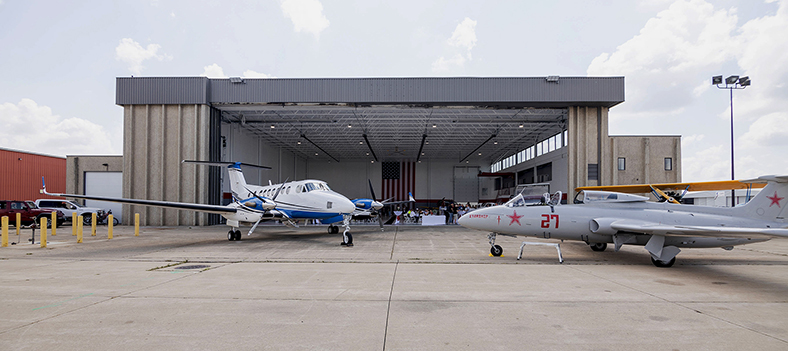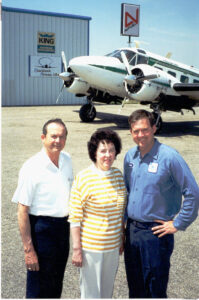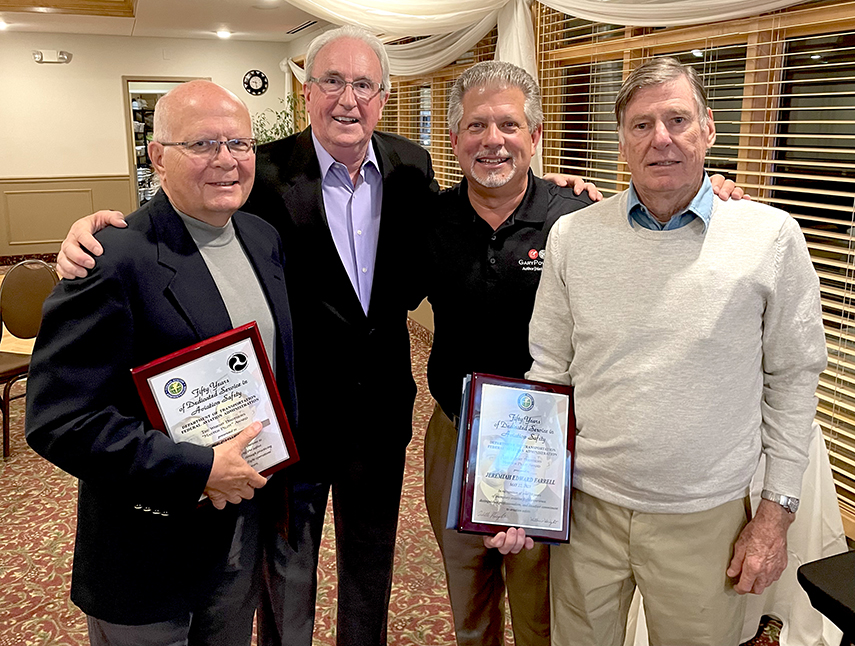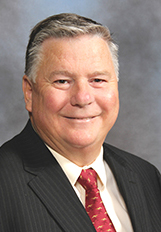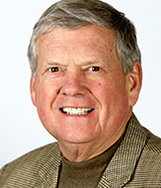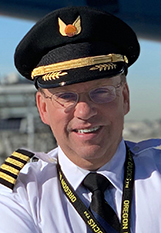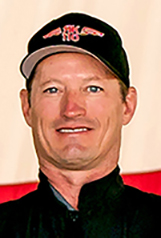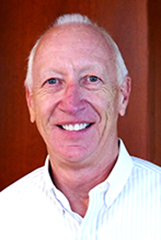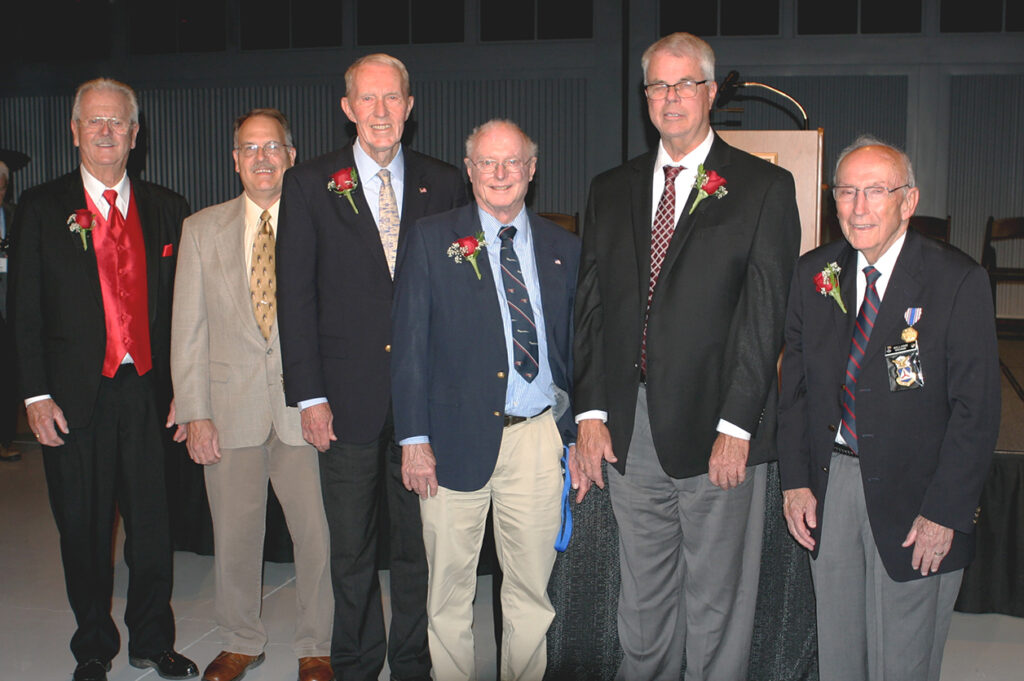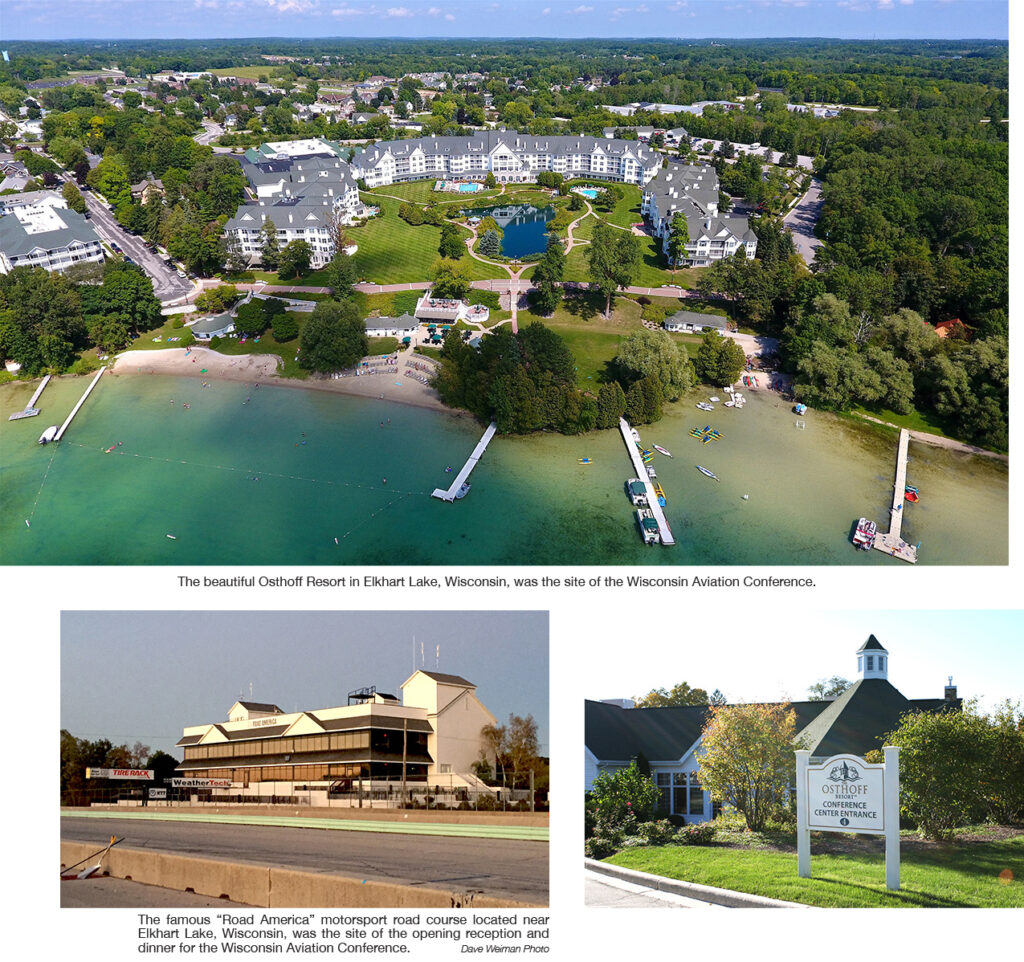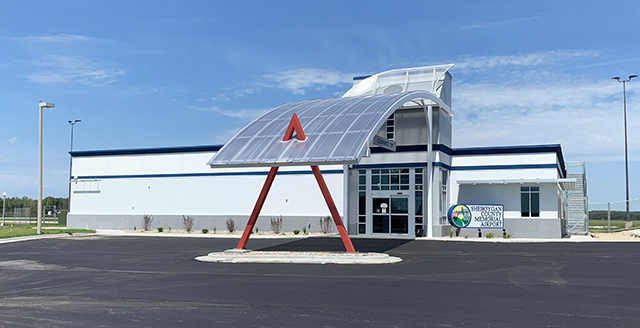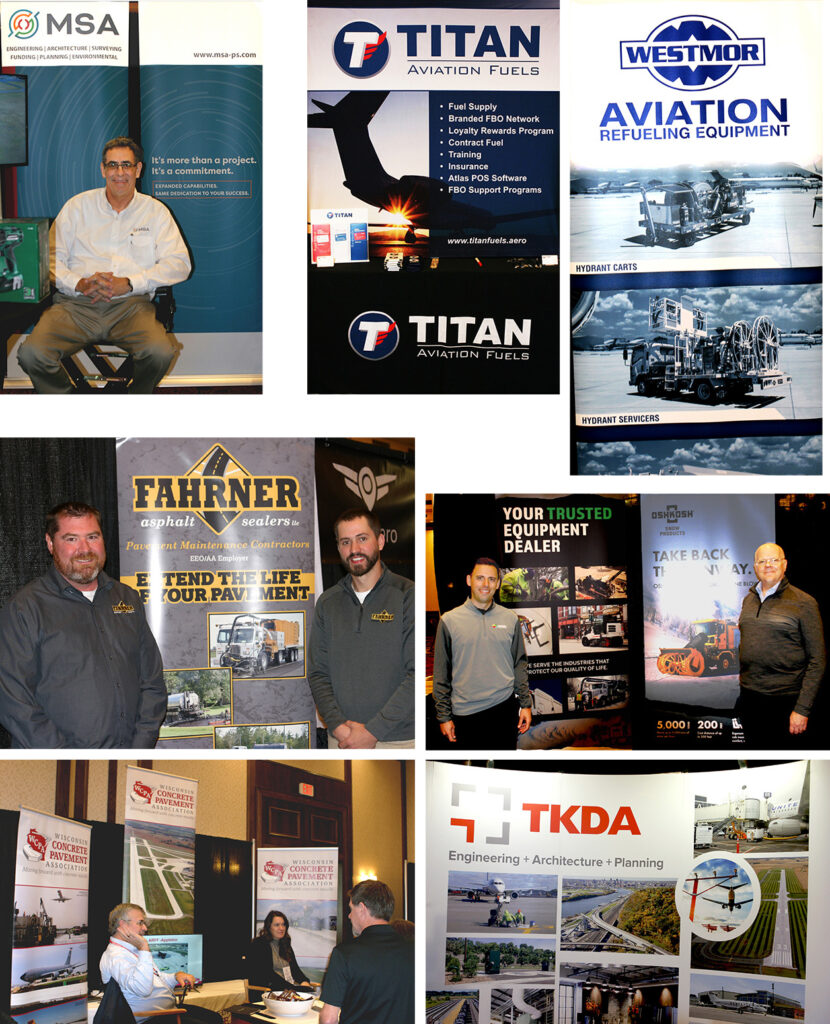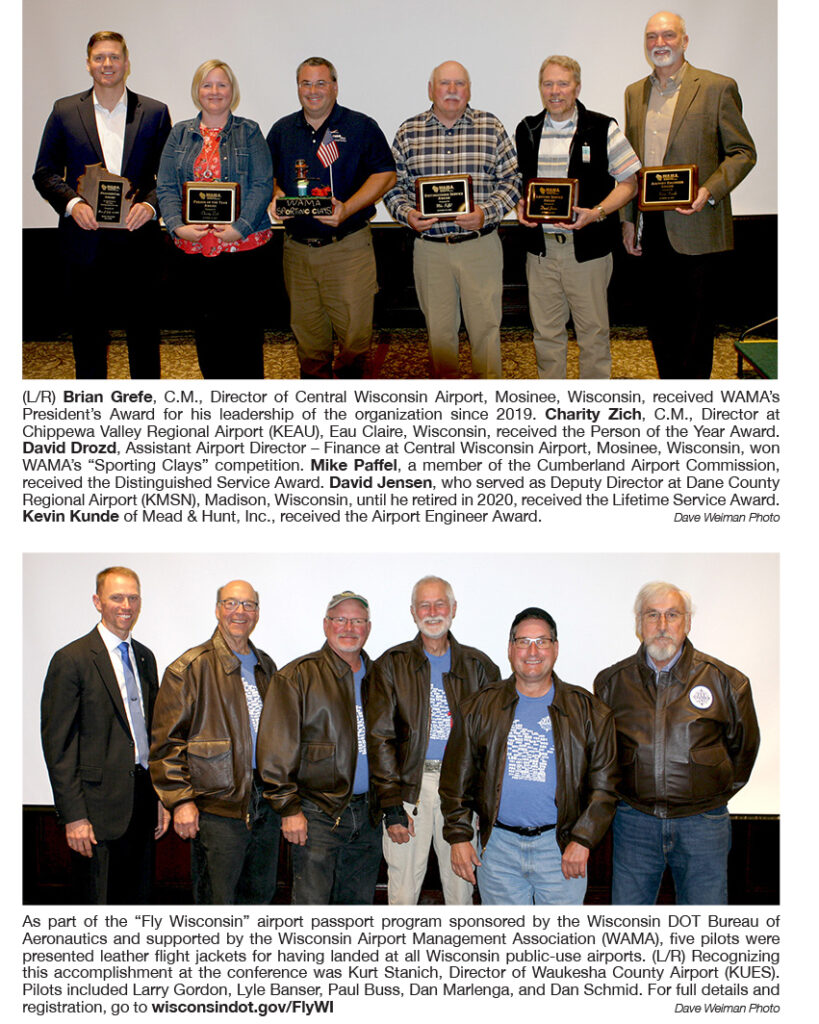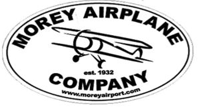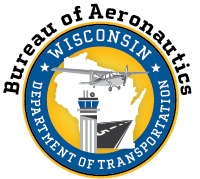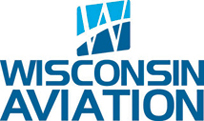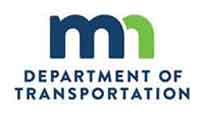Photos by Randy Arneson
Published in Midwest Flyer Magazine – December 2021/January 2022 Online Issue
BLOOMINGTON, MINN. – The Minnesota Aviation Hall of Fame Induction Ceremonies was held October 30, 2021, at the DoubleTree by Hilton Hotel Bloomington – Minneapolis South. Persons inducted included Eugene R. Andreotti, Jr., Dr. Harold H. Brown, Chester W. Hazelton, Glenn L. Hovland, Barbara J. Wiley-Lindquist, James T. Hancock, and William A. Mavencamp.
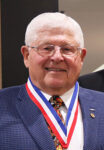
Eugene Andreotti, Jr.
Eugene Andreotti, Jr. (Maj Gen Ret), long associated with the Minnesota Air National Guard, was Minnesota Adjutant General, 1988-2003. Andreotti was born in St. Paul, Minnesota and earned a bachelor’s degree in Political Science from the University of Minnesota. He worked briefly for North Central Airlines and later for Blue Cross/Blue Shield.
Joining the Minnesota Air National Guard, Andreotti was commissioned after graduation from pilot training at Laughlin Air Force Base, Texas. In 1971, he began flying the Boeing C-97 Stratofreighter. He was an air technician and held many positions, including Chief Safety and Maintenance Group Commander for the 133rd Airlift Wing (AW). Andreotti later transitioned to the C-130 Hercules and logged over 5,000 hours of flight time.
In 1988, Minnesota Governor Rudy Perpich appointed Andreotti Minnesota Adjutant General; the first and only Air National Guard member to be appointed to that position, which he held thru 2003.
Andreotti advocated for and installed at Minneapolis and Duluth, the Starbase Minnesota education program, which has served over 50,000 inner city students, teaching them technology and aeronautics through the Science, Technology, Engineering and Math (STEM) Program.
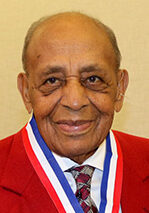
Dr. Harold H. Brown
Dr. Harold H. Brown was a Tuskegee Airman during World War II, served in the Korean War, and was a pilot with the Strategic Air Command (SAC), college vice president, lecturer, and book author.
Brown was born in Minneapolis, Minnesota, and is a graduate of Minneapolis North High School. He took his first airplane ride at Wold-Chamberlain Field in 1941 and soloed at Moton Field in Tuskegee, Alabama, after enlisting in the Army Air Corps.
Brown trained in the PT-17, BT-13 and AT-6 and was assigned to fly fighter aircraft. He went on to fly combat missions in the P-47N Thunderbolt, P-38 Lightning and the P-51C/D Mustang. His first assignment was with the 332nd Fighter Group at Ramitelli Airfield, Italy. Flying his 30th mission in Italy, he was strafing a German train when the locomotive’s boiler blew up and shrapnel damaged his engine, forcing him to bail out. He was captured and spent the last few weeks of the war in a German prisoner of war camp.
After the war, Brown received orders to be an instructor at Lockbourne Air Force Base, Columbus, Ohio. At the start of the Korean War, Brown was transferred to the Far East Material Command at Tachikawa, Japan. He flew missions from Taegu, Pusan, and Seoul bases in Korea. During one flight, he experienced an explosive decompression while flying an F-80 Shooting Star jet fighter. The canopy departed the aircraft, taking the rudder with it… also leaving a two-inch gash along Brown’s flight helmet. The canopy almost took his head off! Brown was able to safely land the aircraft.
Following the Korean War, with his unit still segregated, Brown was again assigned to Tuskegee Army Airfield as a flight instructor. He went on to earn qualifications as a bombardier/navigator while stationed at Lockbourne AFB a second time. He then advanced to become an electronics instructor and then supervised other instructors as the chief of basic electronics. As a senior pilot, Brown was selected to serve in the Strategic Air Command where he qualified as a B-47 pilot. In January of 1958, his unit’s mission transitioned from reconnaissance to electronic countermeasures. Eventually Brown became a flight instructor on the B-47. In 1961, he was hand selected to be a SAC Command Post Controller.
In 1965, Brown transitioned from active duty as a Lt. Colonel and attended Ohio University, receiving a degree in Mathematics. He went on to obtain his doctoral degree and taught at Columbus Area Technical School. He became chair of the Electrical Engineering Program and eventually vice president of Columbus State Community College.
Chester W. Hazelton (1910-2001) was an aerial photographer with Mark Hurd Aerial Surveys, and a global photographer. He was born in Minneapolis, Minnesota, and began flying at Freeman Aircraft Service in 1933 in an OX-5 Travel Air. He received his Private, Commercial and Transport Pilot Certificates the same year. He worked briefly at Freeman Aircraft Service as an instructor and special assignment pilot.
Hazelton spent the largest part of his career flying aerial photography missions. He joined the Mark Hurd Aerial Survey Company in 1938, flying missions for the Soil Conservation Service and the U.S. Geological Survey. Based out of St. Cloud, Minnesota, Hazelton flew mapping flights over northern Minnesota, and in New York, Massachusetts, Pennsylvania, and Maine.
When World War II broke out, the government had absorbed most of the Hurd employees and aircraft. Because of that, Hazelton joined Pratt & Whitney’s aircraft service department, training military mechanics on the installation of engines. Later he worked for Springfield Flying Service in Springfield, Missouri, ferrying new Cessna aircraft to customers. Following the war, Hazelton returned to the Twin Cities and worked at Northwest Airlines for one year, then returned to the Mark Hurd Aerial Survey Company in 1955.
At the time of his death in 2001, Hazelton had accumulated over 20,000 hours of flight time.
Glenn L. Hovland (1920 – 1994) was a World War II flight instructor, balloon flight support pilot, and corporate pilot.
A native of Austin, Minnesota, he enlisted in the Army Air Corps in 1941, and became a flight cadet, soloing in 1942. He went on to earn his wings and a commission as a 2nd Lieutenant. He was assigned duties as a flight instructor at Yuma, Arizona; Pecos, Texas; and Lincoln, Nebraska, accumulating over 2,200 flight hours.
After he transitioned out of the Air Corps in 1945, Hovland embarked on an extensive aviation career beginning as a civilian instructor at Oxnard, California. In 1946, he moved back to Austin, Minnesota, where he flew charter flights across the country for local businesses in a Navion, which was named “Spam Town” after his hometown’s most famous product. He partnered with Austin Aero Service and continued flight instructing while serving as a Civil Air Patrol commander.
During this period, Hovland flew charter flights for several well-known politicians, including Adlai Stevenson, Estes Kefauver and President Dwight D. Eisenhower.
In September 1955, Hovland was hired to ferry Lockheed Lodestars from Spain to Minneapolis where they were to be demilitarized and sold for civilian use. It was during this time that he worked as a chase plane pilot for high-altitude balloons. Among the balloons Hovland tracked was the balloon piloted by Joseph Kittinger in “Project Manhigh,” a pre-space aeromedical project of the U.S. Air Force from 1955-1958. Hovland tracked the balloon from South St. Paul, which reached an altitude of 95,000 feet. Under a follow-up project, Hovland tracked Major David Simons on another epic flight that topped an altitude of 101,000 feet.
Hovland later worked for Minnesota Airmotive and became a corporate pilot for Hormel Company. Hovland flew at least 6,800 hours chasing balloons and over 40,000 hours in all when he retired in 1982.

Barbara J. Wiley-Lindquist
Barbara J. Wiley-Lindquistis a native of Robbinsdale, Minnesota. Her father gave Wiley her first airplane ride at Minneapolis-Crystal Airport. She later soloed a Cessna 150 in 1965 and earned her Private Pilot Certificate a year later. By 1971, she went on to earn her Instrument, Seaplane, Instructor and Air Transport Pilot Certificates, a Bachelor of Science Degree in Education from the University of Minnesota, and taught in the Osseo, Minnesota School District.
Once Wiley accumulated 4000 hours of flight time instructing and flying charter at Crystal Shamrock, she applied at North Central Airlines. Because she was a woman seeking a job in a male-dominated occupation, she masked her gender on the application by only using her first initial and last name.
Wiley was hired by North Central Airlines in 1974 as a First Officer and flew the Convair 580, becoming one of the first women hired by a major airline to fly “right seat.”
Wiley’s pioneering career continued with her becoming a DC-9 first officer in 1977, Convair 580 captain in 1979, DC-9 captain in 1984, and an Airbus A320 captain in 1991. She achieved the rank of captain on the Boeing 747-400 in 2004. Following her retirement from the airlines in 2005, Wiley transitioned to screening and interviewing prospective pilots for Compass and Endeavor Airlines.
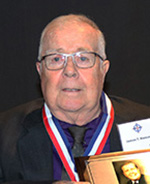
James T. Hancock
James T. Hancock is a Vietnam veteran, was a captain with Northwest Airlines, a pilot examiner with the Federal Aviation Administration, an aircraft homebuilder, and made 1,000 parachute jumps. During his flying career, Hancock accumulated over 19,000 flight hours.
William A. Mavencamp of Maple Lake, Minnesota, was involved in Vocational Flight Training from 1970 until 1978. An FAA-designated examiner from 1972-2010, Mavencamp gave more than 20,000 checkrides during his career. He passed away in 2015.
In addition to the inductees, the Minnesota Aviation Hall of Fame recognized Marsha S. Bordner as “Best Aviation Writer of The Year” for her book “Keep Your Airspeed Up,” and sculptor Nicholas Legeros, as “Best Aviation Artist of The Year.”
The master of ceremonies for the event was the host of the radio program “World of Aviation,” Al Malmberg. The program is sponsored by Academy College and Thunderbird Aviation and is heard each Sunday morning at 10:05 a.m. (CT) on am1280ThePatriot.com (www.academycollege.edu and www.thunderbirdaviation.com).
Minnesota Aviation Hall of Fame sponsors include the MSP Airport Foundation (Foundation Sponsor), Delta Air Lines (Forever In-Flight Sponsor), Cirrus Aircraft and Signature Flight Support (Jet-Setters Sponsors), Aircraft Owners & Pilots Association (AOPA) and Wipaire, Inc. (Pioneer Sponsors), and JETPUBS, Inc. and Wings of the North (In-Kind Contributors).
The 2022 Minnesota Aviation Hall of Fame banquet will be held Saturday, April 23, 2022, at the InterContinental Minneapolis – St. Paul Airport Hotel, 5005 Glumack Dr, Minneapolis. Ezra Benham “Ben” Curry, Duane Edelman, Kathy Vesely, Dale Klapmeier, Martin Knutson, and Tim Callister will be inducted.
Ezra Benham “Ben” Curry (1896 – 1991) was born in St. Paul, Minnesota. He began his career as a railroad locomotive cleaner and was recruited as a civilian in 1917 by the Norton-Harjes Ambulance Service of France to drive battlefield ambulances. He had hoped to join the French Army but returned to St. Paul later that year when the ambulance service was disbanded. Curry then returned to St. Paul and enlisted in the U.S. Army Signal Corps Reserve, where he soloed a Curtiss Jenny in 1918 and served as an engineer.
In 1942, Curry was hired by Northwest Airlines and assigned the General Manager of Northwest Airlines’ Vandalia, Ohio B-24 Modification Center. In 1944, he was transferred to the Holman Field, St. Paul Modification Center. Under his supervision, B-24s were retrofitted with radar units, and converted to tankers and camera ships. In 1946, following the war, Curry’s family bought Island View Lodge on Gull Lake near Brainerd and he returned to work for Northwest Airlines as the contract manager at the Boeing plant in Seattle to build B-377 Stratocruisers. When he returned to Minnesota, he became the supervisor of line maintenance, and in 1951, he became manager of the mechanical division. In 1952, he resigned to work at the family lodge full-time.
In 1962, Curry got current again and joined the Crow Wing Flying Club at Brainerd and flew a Beechcraft Bonanza. He retired from active flying at age 74. Curry’s original pilot’s license was 4651.
Duane V. Edelman (1941 – ) grew up on a dairy farm near Clintonville, Wisconsin. As a young boy, he saw a North Central Airlines DC-3 fly overhead and announced to his brother and father “that’s what I’m going to do when I grow up” and he did. He enlisted in the U.S. Air Force straight out of high school in 1959 and became an aircraft crew chief, eventually maintaining F-100s for the U.S. Air Force Thunderbirds demonstration team. Edelman moved to Sioux City, Iowa to learn to fly and received his Commercial Pilot Certificate in 1964. He flew skydivers and made mortuary flights to build time, receiving his Airline Transport Pilot Certificate in 1966. He was hired by North Central Air Lines and flew DC-3s, the very aircraft and airline that had inspired him as a kid. He lived in Minnesota and worked for the airline for 38 years through its mergers with Republic and Northwest, flying the Convair 440 and 580, DC-9, and Boeing 727, 757 and 747.
Numerous letters of support list the many non-flying positions Edelman held with the airlines. At the time of the merger with Northwest Airlines, he held the title of Director of Flight Operations, while continuing to fly the line. Northwest then appointed him Director of Flight Technical, where he worked on the implementation of the electronic flight bag, electronic clearance and taxi clearance. He was then given the title of Temporary Vice President in order to become Chairman of the SAE S7 Committee for the International Air Transport Association (IATA), writing guidelines for international operations. For this work, Northwest Airlines awarded him the “President’s Award.”
After retiring from Northwest Airlines, Edelman started his own company, Aircraft Data Fusion. The company worked on launch and recoverable space vehicles for the X-Prize competition, and with Honeywell on human factors. He worked on the concept of Free Flight, which would allow aircraft to control themselves to separate from other traffic, and the integration of supersonic aircraft into an airline operation (www.aircraftdf.com).
Edelman has served with the following associations: ATA Airport Surface Movement Committee, Windshear Detection System working group, University of Minnesota Aeronautics Advisory Curriculum Committee, Space Transportation Association Advisory Board for business cases for commercial space tourism, Pratt & Whitney Advanced Engine Design Advisory Board, and Rockwell Collins Pilot Advisory Board. He is a member of the association of pilots, Quiet Birdman (QB), and continues to fly his own Cessna 182 Skylane.
Kathleen R. Vesely (1954 – ) of Golden Valley, Minnesota was born in Bemidji, Minnesota. She got her first airplane ride from an itinerant seaplane pilot at the city’s seaplane docks on Lake Bemidji in 1964. She went to college in Bemidji, where she studied Geology and Geography, and Planning and Environmental Studies. She began her career working for the Minnesota Department of Transportation (MNDOT) in Bemidji on highway construction planning and surveying.
Vesely met her husband, Mike Fowler, after moving to the Twin Cities. She was able to transfer to the MNDOT St. Paul office. In 2002, after 20 years working on roads, she transferred to the Aeronautics Office where her knowledge of geology, geography and environmental issues made her a natural for the job.
Vesely was able to guide airport operators with their planning and compliance with MNDOT funding requirements. Her skills in coordinating the two elements – funding and airport needs – were central to her ability to get things done. She emphasized long-range planning, allowing both funding agencies and airports to see 10 or 20 years into the future.
Vesely was appointed Assistant Aeronautics Director under Cassandra Isackson. She then canvassed every airport in Minnesota to help determine their future needs. The FAA was so impressed with her work that it allowed her to coordinate Minnesota airports with federal funding needs.
Vesely retired from MNDOT in 2020 after 41 years of service, including 18 years with the Minnesota Office of Aeronautics.
Vesely bought her husband flying lessons for his 40th birthday. After the couple purchased and restored a Cessna Cardinal, they both took flying lessons.
Born in DeKalb, Illinois, Dale E. Klapmeier (1961 – ) attended the University of Wisconsin-Stevens Point, graduating with degrees in Business Administration and Economics. Growing up he built model airplanes, frequented the local airport, and dreamed of designing his own airplane. He started flying at age 15 in a Cessna 140 he and his brother, Alan, bought together. The brothers then rebuilt a wrecked Aeronca Champion and built a Glasair homebuilt aircraft.
In 1984, the Klapmeier brothers founded Cirrus Design Corporation in the lower level of their parents’ rural dairy barn. Their first design was the VK30, a pusher-type aircraft, which they built at their Baraboo, Wisconsin facilities. Along with their aircraft designs, the Klapmeiers pioneered an emergency parachute recovery system for aircraft, designed to lower a nonfunctioning aircraft to the ground, saving the lives of its occupants. The concept has also become a major marketing tool.
In 1998, the Cirrus SR20 was certified, followed by the SR22 in 2000. The aircraft design continued to evolve, the number of manufacturing employees kept increasing, and the production plant continued to grow. The Klapmeiers soon outgrew their Baraboo, Wisconsin facilities and they moved to Duluth International Airport in Minnesota, and later established another facility in Grand Forks, North Dakota. The SR20 and SR22 feature all-composite airframes, full glass cockpits and side-stick controls. By 2003, the SR22 had become the highest selling general aviation aircraft in the world! The company’s most recent design is the SF50 Vision Jet, a single-engine personal jet aircraft, which was certified in 2016. In 2011, Cirrus was sold to China Aviation Industry General Aircraft (CAIGA), but Dale Klapmeier remained the company’s CEO until 2019.
Martin Knutson (1930 – 2013) was born in Minneapolis, Minnesota. He graduated from St. Louis Park High School and attended the University of Minnesota majoring in Electrical Engineering in the Navy’s Holloway Plan, which was a program that paid for college while the student served in the military. While working in the Pacific Fleet during the summer of 1949, Knutson took his first airplane ride in the ball turret of a Grumman TBM Avenger. It was after that flight he decided it would be better to be in the cockpit where the controls were.
In 1950 Knutson transferred to the Air Force for flight training, where he trained in the T-28 and F-80A. Upon graduation, he was assigned to a jet fighter squadron and deployed to Korea where he flew combat missions in the F-80 and F-86.
Following Korea, Knutson was assigned to the Strategic Air Command (SAC) as a fighter pilot stationed at Turner AFB, Georgia, where he flew the Republic F-84, training for long-range nuclear strike missions. In 1955, Knutson volunteered for assignment to the Central Intelligence Agency (CIA) where he participated in the flight testing of the Lockheed U-2, nicknamed “Dragon Lady,” a single-engine, high-altitude jet reconnaissance aircraft. He was then deployed to Europe and flew missions over the Soviet Union. Knutson continued to fly covert missions over ‘denied territory’ throughout the world until his retirement from the Air Force in 1970.
Following his retirement, Knutson joined the National Aeronautics and Space Administration (NASA) Ames Research Center in California as Manager of Earth Resources Projects. There he helped develop airborne remote sensing equipment for observation satellites. He helped modify U-2 aircraft for earth sensing missions regarding sea and land ice, wildlife habitat, ozone depletion, air pollution, typhoon dynamic structure, and other environmental projects.
Knutson moved on to become the NASA Site Manager at the Dryden Test Flight Facility. This was during the beginning of the Space Shuttle program when most of the Shuttle landings were made at Edwards Air Force Base. At Dryden, he participated in many unique test programs and was responsible for NASA obtaining three SR-71 aircraft for environmental missions, after the Air Force had retired them. At the age of 67, Knutson flew an SR-71 to a speed of Mach 3.275. He retired from NASA in 1997.
Knutson served a combined 47 years with the Air Force, CIA and NASA. He amassed over 4000 flight hours in the U-2 during his 29 years flying the aircraft.
A native Minnesotan, Timothy C. Callister (1947 – ) was born in Owatonna and raised on a farm in West Concord. At the age of 7, he decided he wanted to be an airline pilot. As a gift from his parents, he experienced his first airplane ride on a North Central Airlines flight from Minneapolis to Rochester. Callister later decided he wanted to become a Department of Natural Resources Conservation Officer; however, world events disrupted that plan. The U.S. involvement in Vietnam was escalating and in 1968, he joined the U.S. Army. As a Warrant Officer, he served in the 189th Assault Helicopter Company in Vietnam. During his time in Vietnam, he was awarded the Distinguished Flying Cross for his heroic actions in suppressing heavy enemy fire during a rescue mission. He was also awarded the Bronze Star and the Air Medal.
Following his service in Vietnam, Callister returned to Minnesota and attended St. Cloud State, graduating with a degree in Transportation and Urban Planning. While attending the university, he joined the Minnesota Army National Guard and became a helicopter instructor for the 47th Aviation Battalion, St. Paul, and as a member of the 2-147th Aviation Battalion, State Area Readiness Command. He retired from the National Guard in 1991.
In 1974, Callister joined the Metropolitan Airports Commission (MAC) and interned in the planning and engineering department, eventually becoming the Manager of the Reliever Airport System, responsible for six general aviation airports, with 750,000 operations a year. In 1986, he was hired as the Minneapolis-St. Paul International Airport Assistant Airport Director. In 1996, Callister moved into the Airport Director’s position, overseeing 250 airport staffers, and was involved in planning, designing and implementation of a $3.1 billion expansion and upgrade to the airport.
In 2004, Callister retired from the Metropolitan Airports Commission and joined Mead & Hunt as a Senior Project Planner for Aviation Services. He also cofounded the Minnesota Council of Airports (MCOA). Callister is also a member of the American Association of Airport Executives (AAAE), and the Vietnam Helicopter Pilots Association in which he served as President of the Upper Midwest Chapter from 2019 to 2020.
Tim Callister has spent his retirement promoting airport matters in Minnesota by speaking on their behalf, serving as an airport tour guide, and mentoring aviation students in finding careers in the airport industry.
Banquet Registration & Hotel Reservations
To register for the 2022 banquet or to make donations, email MAHOFBanquetReservations@gmail.com or call 952-906-2833 (www.mnaviationhalloffame.org).
For hotel reservations, call the InterContinental Minneapolis – St. Paul Airport Hotel, 5005 Glumack Dr., Minneapolis, MN 55450 at 612-725-0500.








